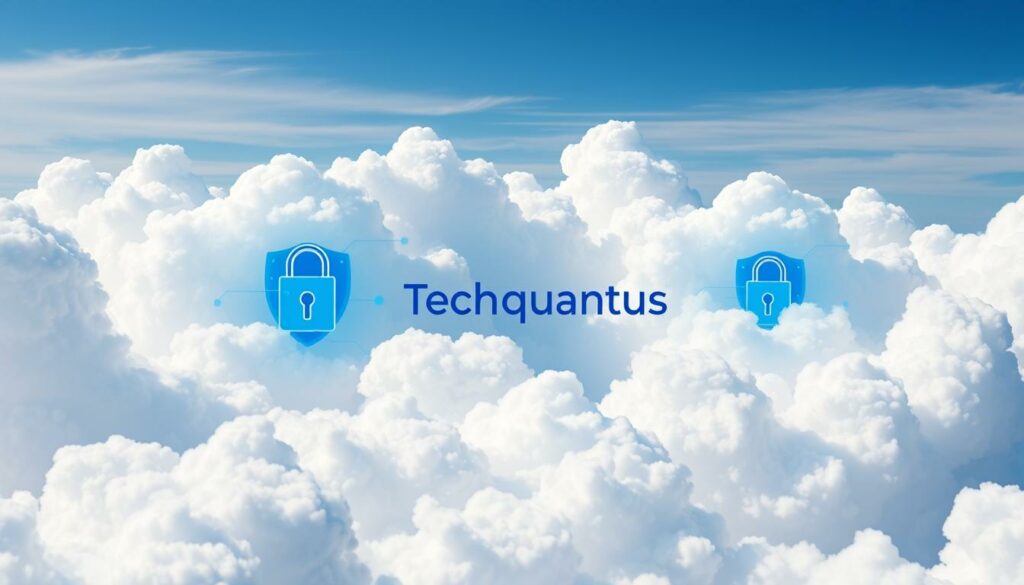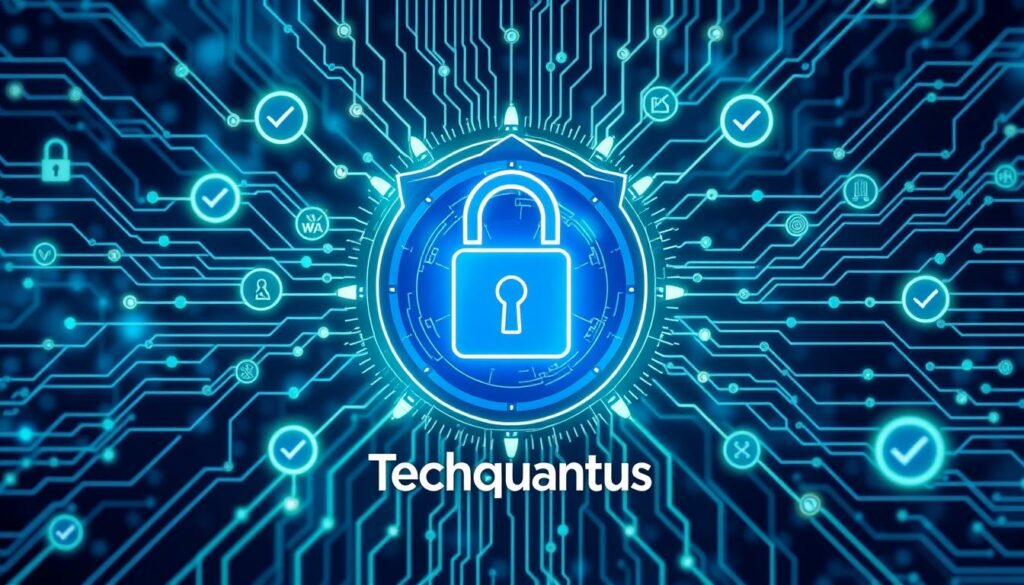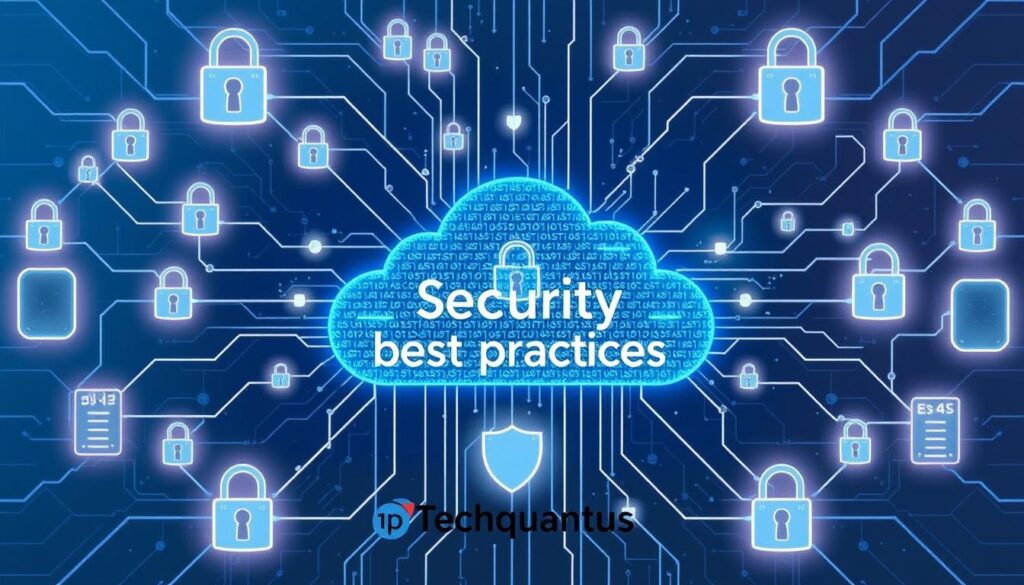Last year, a shocking 94% of companies faced a data breach because of cloud security issues. As more businesses use cloud services, keeping data safe has become a top priority. With new tech and more remote work, protecting data in the cloud is urgent.
Effective Cloud Security not only keeps your data safe but also meets many regulations. This helps avoid data leaks and cyberattacks.
Understanding the shared responsibility in cloud settings is key. Cloud providers do a lot to secure data, but companies must also take steps to protect theirs. This article will show you how to keep your cloud data safe. It aims to make your digital space safer for your business.
Key Takeaways
- Understanding the critical nature of Cloud Security is essential for modern businesses.
- Effective data protection strategies help mitigate risks associated with cyber threats.
- Compliance with regulations is a major benefit of strong cybersecurity measures.
- Organizations must actively engage in securing their cloud environments.
- Implementing best practices can enhance overall IT Security.
Understanding the Importance of Cybersecurity in the Cloud
As companies move to the cloud, the need for cloud security grows. This move brings many benefits but also new risks. It’s vital to teach employees and leaders about cybersecurity awareness to protect sensitive data.
Cyberattacks are on the rise, especially during global events that make us rely more on the internet. The threat landscape keeps changing. This means we need strong plans to prevent data breaches. Regular checks on security help spot and fix risks in cloud services.
Experts say being proactive with cloud security is key to keeping customer trust and protecting a company’s reputation. Investing in good security helps make a safer space for data and clients.
To tackle cybersecurity well, we must look at many different things. Companies should focus on training that boosts cybersecurity awareness. This makes employees aware of threats. For more on how to secure your data, check out this resource.
Common Threats to Cloud Security
More companies are using cloud systems, which brings many cyber threats. It’s crucial to know these threats to protect well. Data breaches are a big worry, with hackers getting better at finding weak spots.
Account hijacking is a big risk. Hackers use phishing to get into user accounts without permission. In June 2024, a group called WikiLoader changed its tactics, using GlobalProtect-themed SEO poisoning instead of phishing. This shows how cloud security risks are always changing, making us all more careful.
Weak APIs are another common problem. APIs are key in cloud services, but if they’re not secure, they can lead to data breaches. A report from Unit 42 showed WikiLoader targeted U.S. colleges and transport, showing some sectors are more at risk.
More people are using Jupyter notebooks, which means we need better security. About 42% of companies use these for data access, but all users face threats like remote command injection and unauthorized access. Using zero trust security and running multiple Jupyter instances can help protect against these risks.
Implementing Strong Access Controls
It’s vital to have strong access controls to keep cloud data safe. With cyber threats on the rise, using Role-Based Access Control (RBAC) and Multi-Factor Authentication (MFA) can really help. These methods limit who can access data and keep it safe from unauthorized people.
Role-Based Access Control (RBAC)
RBAC is key to controlling access. It gives permissions based on what each person does in their job. This way, users only see the data they need, lowering the chance of data leaks. With RBAC, it’s harder for hackers to get into systems.
Multi-Factor Authentication (MFA)
MFA is also crucial for security. It makes users prove who they are with more than just a password. By asking for something you know, something you have, or something you are, MFA cuts down on unauthorized access. Adding MFA to other security steps makes it even harder for hackers to get in.
| Access Control Type | Description | Benefits |
|---|---|---|
| Role-Based Access Control (RBAC) | Limits access based on the user’s role within the organization. | Reduces exposure of sensitive data and minimizes internal threats. |
| Multi-Factor Authentication (MFA) | Requires multiple verification methods for access. | Significantly decreases the chances of unauthorized access. |
| Zero-Trust Security | Involves verification at every stage of user access. | Enhances control over user permissions and reduces the risk of breaches. |
Data Encryption Techniques for Protection
Data encryption is key to keeping your sensitive info safe in the cloud. Using strong encryption helps protect your data, making it hard for others to get into. Let’s look at how to encrypt data both when it’s sitting still and when it’s moving, and why end-to-end encryption is a big plus.
Encrypting Data at Rest and in Transit
Encrypting data at rest keeps info safe on servers, keeping it away from prying eyes. Without encryption, stored data is at risk of being stolen or leaked. Encrypting data in transit is just as crucial, as it keeps data safe as it moves between users and cloud services.
Using End-to-End Encryption
End-to-end encryption keeps data safe from the start to the end. It makes sure no one, not even service providers, can see your data. This is key as we use more cloud services, helping to keep data safe from hackers.
Using encryption makes your data safer and builds trust with your customers. Checking your encryption often and following laws like GDPR helps keep your data safe. For more on how to use encryption well, check out this resource.
| Encryption Type | Description | Benefits |
|---|---|---|
| Data at Rest | Secures stored data on servers. | Prevents unauthorized access and data breaches. |
| Data in Transit | Protects data transferred between user and cloud. | Safeguards against interception and unauthorized access. |
| End-to-End Encryption | Encrypts data from sender to recipient only. | Ensures data privacy and reduces access risks. |
Best Practices for Data Backup and Recovery
Effective data backup strategies and recovery plans are key to keeping your data safe. With more threats to information security, it’s important to use strong cloud data protection. Regular backups save time and make sure your data is safe against accidental deletion or cyberattacks.
Here are some top tips for data backup and recovery:
- Automate your backups: Regular scheduled backups help avoid mistakes and keep your data current.
- Store backups in multiple locations: Use both on-premises and cloud storage. This protects your data from physical disasters and adds extra security.
- Regularly test recovery plans: Test your recovery plans often. This makes sure you can quickly recover in real situations.
Following these tips can greatly reduce downtime if there’s a breach. It lets your business keep running smoothly. Cloud data protection is key in making sure you can access important data when you need it.
Enhancing Security with Cloud Service Providers
Choosing a trustworthy cloud service provider is key to keeping your data safe. They use strong security steps to protect your info. It’s important to check their security plans before you decide on a cloud service.
Evaluating Provider Security Measures
Before picking a cloud service provider, look at their security steps. Important things to think about include:
- Compliance Certifications: Make sure they meet standards like ISO 27001 or SOC 2.
- Data Encryption: Check they use strong encryption for data at rest and moving data.
- Incident Response Strategies: Look at how they handle security issues.
These steps are key to trust in cloud service providers. They help you feel secure before moving your data. The growth of industries shows how important it is to keep sensitive info safe, like the big growth in public cloud use.
Choosing the Right Service Model
Choosing between IaaS, PaaS, or SaaS affects your security level. Each model has different security duties:
| Service Model | Provider Responsibility | Your Responsibility |
|---|---|---|
| IaaS | Security of infrastructure, servers, and storage | Security of the network, OS updates, and apps |
| PaaS | Security of infrastructure and platform | Management of apps and data |
| SaaS | Security of apps, data, and infrastructure | Security of user access and management |
Knowing these differences helps you pick the right provider and model for you. With the public cloud market growing, these choices will be more important as companies move online. For more info on the market growth, check out this link.

Continuous Monitoring and Threat Detection
In today’s fast-changing digital world, continuous monitoring is key to cloud security. These systems help spot security issues right away. This means threats are stopped before they can cause big problems. Using strong threat detection strategies is vital to keep your data safe.
Modern cloud security tools make it easy to watch over your data in real-time and handle incidents fast. They use machine learning to check global threat data and watch for attacks. For instance, tools like SafeLine use big data analytics to quickly find and identify unknown security threats accurately.
Being proactive in security means always checking your setup. This helps you find new weaknesses and act on them. Good continuous monitoring systems tell cloud security teams about strange happenings and possible security issues. This helps protect your data better.
Here’s a closer look at what top-notch continuous monitoring and threat detection solutions offer:
| Feature | Description | Benefits |
|---|---|---|
| Real-time Analysis | Constant checking of data traffic and user actions. | Finds unauthorized access and oddities right away. |
| Automated Threat Identification | Uses algorithms to spot possible security threats. | Speeds up responding to incidents. |
| Minimized False Positives | Advanced rules cut down on false alarms. | Helps teams focus on real threats and lowers alert overload. |
| Comprehensive Reporting | Provides insights into security level and incident patterns. | Helps with following rules and guides on how to get better. |
By using continuous monitoring and the newest cloud security tools, companies can keep their systems safe from new threats. Adding these technologies helps improve your threat detection plans. This leads to better security and strength in the cloud.
Compliance with Security Regulations
In today’s world, companies must follow strict rules to keep sensitive info safe. It’s key to know about laws like GDPR and HIPAA. These rules set the bar for how to protect personal data. Not following them can result in big fines and harm to a company’s image.
Understanding GDPR and HIPAA Requirements
GDPR says companies handling EU citizens’ data must protect it well. This means getting clear consent, keeping data to a minimum, and handling requests from data subjects well. In the U.S., HIPAA has rules for keeping health info safe. It focuses on keeping patient data private and secure.
- Key aspects of GDPR:
- Right to access personal data
- Mandatory data breach notification
- Data portability requirements
- Key aspects of HIPAA:
- Privacy Rule for health information
- Security Rule for electronic data
- Transaction standards for health care providers
Regular Security Audits and Assessments
Doing regular security checks is vital for following the rules. These checks spot weak spots and check how well data is protected. They make sure you follow the rules and keep data safe.
Here’s how to keep up with security checks:
- Review security policies and procedures
- Test how you handle incidents
- Check if employees know about security and rules
Creating a culture of following the rules and checking your security often helps. It keeps your organization safe and builds trust with your customers.

| Regulation | Key Focus | Penalties for Non-Compliance |
|---|---|---|
| GDPR | Data protection for EU citizens | Up to €20 million or 4% of global revenue |
| HIPAA | Protection of health information | Fines up to $1.5 million per violation |
Training Employees on Cloud Security Risks
Effective employee training is key to fighting off threats in cloud settings. It boosts Cloud Security awareness among your team, making your system less vulnerable. Without knowledge, employees can fall for phishing attacks, leading to big security issues.
Having ongoing training keeps your team up-to-date with new security policies and practices. Knowing these rules helps employees spot and report suspicious actions quickly.
Hands-on training is very important. Regular workshops and simulations make learning stick. Interactive discussions and practical exercises help employees remember and use what they learn.
Creating a security-focused culture makes everyone responsible. When all team members value Cloud Security awareness, the risk of breaches goes down. Adding security talks to daily discussions and meetings keeps everyone on the same page.
Also, updating security policies regularly keeps employees in line with company goals. Training should keep up with tech changes and new threats. Offering support and resources lets your staff help make the cloud safer.
For more on boosting security, check out search engines like DuckDuckGo or Ecosia for tips on protecting privacy. Teach your team about these by reading this article.
Conclusion
In this Cloud Security summary, we looked at how to keep your data safe in the cloud. We covered important topics like strong access controls and encrypting data. We also talked about the need to keep an eye on things and follow security rules.
Using things like multi-factor authentication and encrypting data helps a lot. Training your employees about security risks is also key. It helps create a culture of awareness that’s crucial for keeping data safe.
Remember, keeping your cloud secure is an ongoing job. It’s important to stay up to date with new threats and follow best practices. By doing this, you’ll be ready to protect your data in our digital world.
FAQ
What is Cloud Security and why is it important?
Cloud Security protects data, apps, and cloud computing infrastructure. It’s key for keeping sensitive info safe, following rules, and stopping data breaches that could cause big financial losses.
What are common threats to Cloud Security?
Threats include data breaches, account hijacking, and insecure APIs. These can lead to unauthorized access and the loss of sensitive data.
How can Role-Based Access Control (RBAC) improve Cloud Security?
RBAC limits access by user roles in an organization. This reduces the risk of unauthorized data access by ensuring only the right people can see sensitive info.
What is Multi-Factor Authentication (MFA) and how does it work?
MFA makes users prove their identity with two or more verification steps to log into accounts. This extra step makes it harder for hackers to get in, even with a password.
Why is data encryption critical in cloud environments?
Encryption keeps data safe at rest and in transit. If data is intercepted or accessed without permission, it stays unreadable and secure.
What best practices should I follow for data backup and recovery?
Use automated backups, keep backups in several places, and test recovery plans often. These steps help reduce downtime and ensure your business can bounce back quickly after a breach.
What should I consider when choosing a cloud service provider?
Look at their security steps, like encryption and how they handle incidents. Picking a trusted provider is key for strong Cloud Security.
How does continuous monitoring enhance Cloud Security?
Continuous monitoring spots security issues early. Using real-time tools lets organizations catch threats fast and fix problems before they get worse.
What regulations should organizations comply with for data protection in the cloud?
Follow rules like GDPR and HIPAA for strict data protection and security. Regular security checks ensure you meet these standards and boost security.
How can employee training improve Cloud Security?
Training employees makes them aware of Cloud Security risks and how to avoid them. It creates a security-focused culture where everyone follows the rules.
Source Links
- KnowBe4 Named Best Workplace in the Middle East
- Siemens Joins Global Battery Alliance
- PEAKLIGHT Dropper: Hackers Target Windows With Downloads
- A Practical Guide to Risk-Based Cybersecurity Reporting.pdf
- Software Development Engineer – II – Cassandra
- Spoofed GlobalProtect Used to Deliver Unique WikiLoader Variant
- Manage Multiple Jupyter Instances in the Same Cluster Safely
- The future of Kubernetes and cloud infrastructure
- 7 Common Challenges in Real-Time Streaming and How to Overcome Them
- Storage technology explained: Kubernetes, containers and persistent storage | Computer Weekly
- No match, but still access to the data: dating apps spill personal data
- Infrastructure as a service (IaaS) Market Sets the Table for Continued Growth
- InnoBlock 2024 Airdrop DemoDay: Forging Deep Connections between Projects and VCs
- Master Aws Cloud Practitioner Certification Exam – Clf-C02
- Public Cloud Market to Surpass USD 2213.7 Billion by 2031, Growing Reliance on Internet and Progressing Technology Industry to Fuel Growth
- Cloud API Market Increasing Investment is expected to boost Market Growth
- Top 10 Latest Trends in AI Development For 2024
- Fortify Your Website for Free: Testing the Power of SafeLine
- Gartner Forecasts Global Information Security Spending To Grow 15% In 2025
- Want to branch out beyond Google? Here are some search engines worth checking out | TechCrunch
- The next business differentiator: 3 trends defining the Gen AI market
- Governments often struggle with massive new IT projects
- Enhancing Crypto Trading for French Speakers Worldwide: Financière de Versailles Achieves 94.8% Success Rate with AI Trade Signals in August 2024
- Get Started with Gemini Gems: Free Month of AI Chatbot Customization
- My Insights on IT projects post-war in Europe
- Augmented Reality in Marketing: Top Strategies for Success
- What Nobody Tells You About AI: My Insights
- Inside Netflix’s Tech Stack: A Captivating Behind-the-Scenes Look
- Generation Tech Zombie: Thriving in the Digital Age
Related posts:
 How to Protect Your Business from Ransomware Attacks
How to Protect Your Business from Ransomware Attacks
 AI in Cybersecurity: The New Frontier in Protecting Data
AI in Cybersecurity: The New Frontier in Protecting Data
 The Rise of Ransomware: How to Protect Your Business
The Rise of Ransomware: How to Protect Your Business
 Boost Data Protection with DLP Security Solutions
Boost Data Protection with DLP Security Solutions
 How to Set Up a Virtual Firewall for Your Cloud Infrastructur
How to Set Up a Virtual Firewall for Your Cloud Infrastructur
 Firewalls and VPNs: How They Work Together to Secure Networks
Firewalls and VPNs: How They Work Together to Secure Networks
